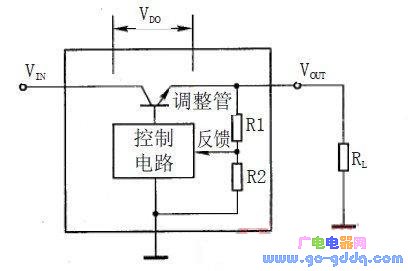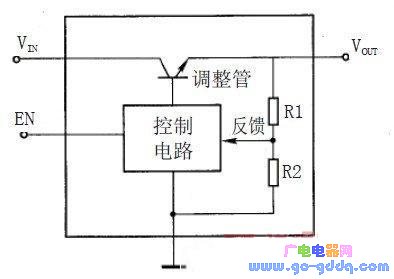The DC-DC converter in PDP color TVs is typically located on various boards such as the power supply board, main board, or logic control board. Due to its critical role in powering the small signal processing circuits, it is more susceptible to failure. As a technician, quickly identifying the location of the DC-DC converter and measuring its input and output voltages is essential for determining whether it is functioning properly.
1. Basic Working Principle of Linear Regulators
A linear regulator regulates the voltage drop (VDO) across the control transistor by using feedback from the output voltage and an error amplifier, as shown in Figure 1. One key characteristic is that the input voltage (VIN) must be higher than the output voltage (VOUT), and the regulator operates in the linear region, which gives it its name. When the input voltage or load current changes, the feedback circuit adjusts VDO to maintain a stable output voltage.
Whether it's a standard linear regulator or an LDO, their basic working principles are similar. The main difference lies in the structure of the adjustment transistor, which allows LDOs to operate with a smaller voltage difference and lower power consumption.
Some linear regulators used in PDP TVs have an output control pin, meaning the output voltage can be controlled externally. Figure 2 shows the internal block diagram of a controllable regulator. The EN pin (sometimes labeled SHDN) is used to enable or disable the regulator, often controlled by a microprocessor. When disabled, the current consumption is typically around 1 μA.

Figure 1: Linear stabilizer block diagram

Figure 2: Internal block diagram of the controllable regulator
2. Characteristics of Linear Regulators
Linear regulators are known for their low cost, compact size, minimal external components, and low noise levels. They come in various package types, making them ideal for use in PDP TVs. For fixed-output applications, only a few capacitors are needed to complete the circuit.
One of the biggest advantages of linear regulators is their extremely low output voltage noise, with ripples below 35 μV and excellent noise rejection. This makes them perfect for powering sensitive signal processing circuits. Additionally, they don't produce large current spikes during switching, resulting in less electromagnetic interference (EMI), which simplifies design.
However, linear regulators are not very efficient and are limited to step-down applications. Their efficiency depends on the ratio of the output voltage to the input voltage, η = Vo / Vi. For example, if the input is 5 V and the output is 2.5 V, the efficiency is only 50%, meaning half of the energy is lost as heat. This is why traditional linear regulators tend to overheat under heavy loads. LDOs, on the other hand, offer much better efficiency due to their low dropout voltage. At 3.3 V input and 2.5 V output, an LDO can achieve up to 76% efficiency.
In modern PDP TVs, where power efficiency is crucial, LDOs are increasingly preferred over traditional linear regulators to reduce heat generation and improve overall performance.
Outdoor LED Screen,Advertising Led Display Screen,Outdoor Display Screen,Outdoor Led Advertising Board
Shanghai Really Technology Co.,Ltd , https://www.really-led.com